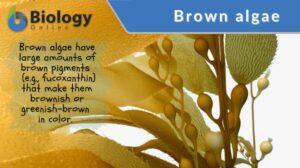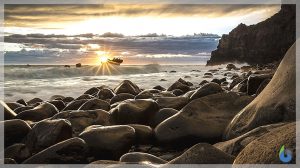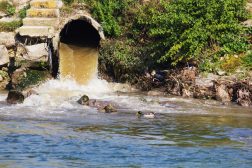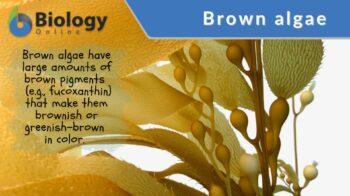
Brown algae
n., singular: brown alga
[bɹaʊn ˈæl.dʒi/ (or ˈæl.ɡi)]
Definition: multicellular algae that are rich in fucoxanthin and other brown pigments
Table of Contents
Brown Algae Definition
Brown algae are algal species characterized by being multicellular and having a brown or greenish-brown color. The color is due to the predominance of brown pigments, e.g. fucoxanthin, in addition to the green pigments (chlorophyll a and c). Many of them are macroscopic. In fact, kelps are large brown seaweeds that grow in shallow oceans and form the so-called kelp forest. Fucus is another macroscopic brown algal species. They thrive in intertidal zones of rocky seashores. They are harvested, dried, and processed for the commercial production of soap, glass, etc. They are also used as fertilizers.
Synonyms: Phaeophyta; Phaeophyceae; Fucophyceae.
Classification
The old scheme of classification entails five major kingdoms. One of them is the kingdom Protista (protists). This group is comprised of three groups: the animal-like protozoa, the plant-like algae, and the fungus-like slime molds and water molds. However, not all algae are microscopic and unicellular as most protists are known for. Many brown algae are macroscopic as already pointed out above. Algae are further divided into several phyla: Euglenophyta, Chrysophyta (diatoms), Pyrrophyta (dinoflagellates), Chlorophyta (green algae), Phaeophyta, and Rhodophyta. (1) Recent studies and findings, though, may lead to changes in the taxonomic positions and newer systems of classification. (2) For instance, the phylum Phaeophyta is now obsolete in many modern references. It used to be the phylum consisting of organisms commonly referred to as brown algae. At present, the brown algae are now members of Phaeophyceae, which is one of the taxonomic classes under the new phylum, Ochrophyta. (3)
Phaeophyceae is comprised of algal species characterized by their brown or greenish-brown color due to the presence of brown pigments, such as fucoxanthin. However, apart from this class, some algal species that are brownish in color have been included here as well, such as the dinoflagellates and the diatoms. However, members of Phaeophyceae are more popularly referred to collectively as the brown algae. In contrast to the two algal groups whose members are single-celled, Phaeophyceae consists of algal species that are multicellular.
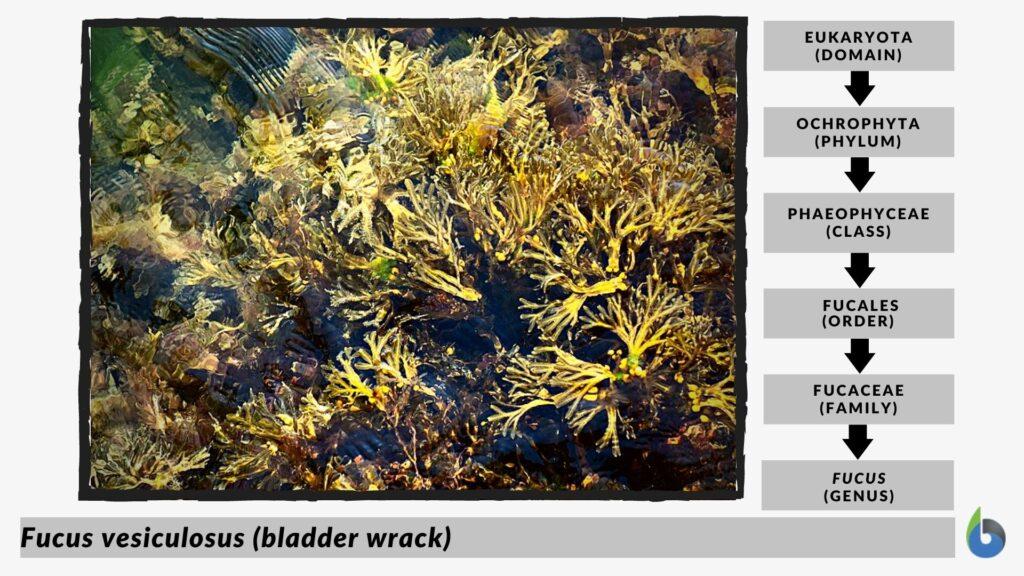
Sub-groups
Phaeophyceae is comprised of the following taxonomic orders(4):
- Ascoseirales
- Asterocladales
- Chordales
- Desmarestiales
- Dictyotales
- Discosporangiales
- Ectocarpales
- Fucales
- Ishigeales
- Laminariales
- Nemodermatales
- Onslowiales
- Phaeophyceae ordo incertae sedis
- Phaeosiphoniellales
- Ralfsiales
- Scytothamnales
- Sphacelariales
- Sporochnales
- Stschapoviales
- Syringodermatales
- Tilopteridales
General Characteristics of Brown Algae
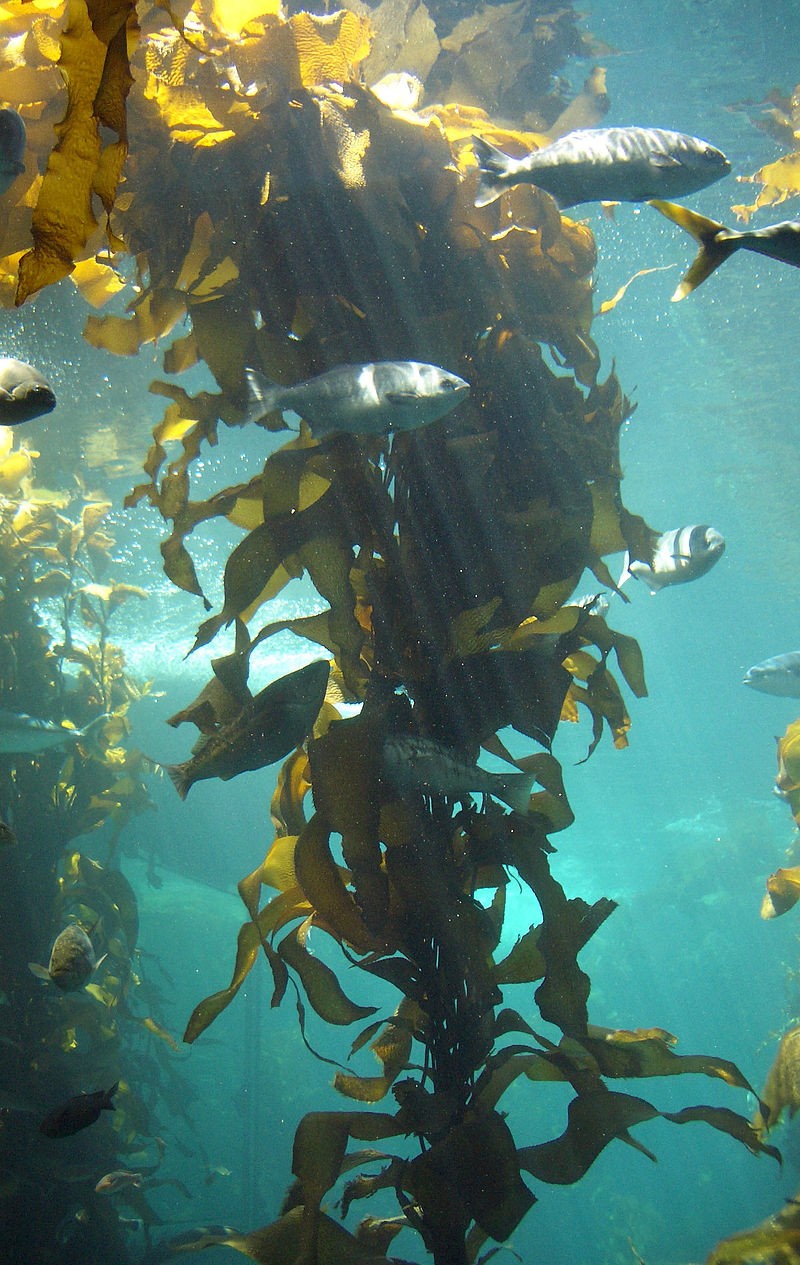
Phaeophyceae is a clade comprised of olive green to brown multicellular algae. The size could range from a tiny tuft of a few centimeters to giant kelp of over 50 meters long. Macrocystis pyrifera (giant kelp) is considered the largest algae. Their characteristic greenish-brown color is attributed to and depends on the amount of fucoxanthin. Apart from this pigment, chlorophyll a and c2 are also present.
Their carbohydrate reserve is laminarin (β1-3 glucose polymer). Similar to other algal groups, brown algae manifests alternation of generations. The sporophyte is often the more visible form. Most of the brown algae (except for the Fucales) reproduce sexually by sporic meiosis. Those that are capable of asexual reproduction reproduce by means of motile zoospores.
The body (thallus) of Phaeophyceae lacks the vascular tissues that are present in tracheophytes. Thus, brown algae do not have true roots, stems, and leaves. The root-like structure of the brown algae is referred to as the holdfast. Similar to a true root, the holdfast serves as an anchor, preventing the algal thallus to be swept away by the current. However, the holdfast is not the primary organ for water uptake as the true root is. The stem-like part of the algal thallus is called a stipe.
In highly-differentiated brown algae such as Fucus, the stipe is comprised of three layers: the outer epidermis, the middle cortex, and the inner central pith. The pith may include a core of phloem-like cells. In other species, the pith may be hollow and gas-filled, and therefore associated with algal buoyancy. The leaf-like structure is referred to as a blade (when it is single and not divided), a frond (when divided), or a lamina (when flattened). The air bladders in the thallus are called pneumatocysts. They increase algal buoyancy.
Brown algae are mostly marine and macroscopic. They flourish especially in cold ocean waters.
Evolution and Phylogeny
Brown algae are presumed to have evolved from a symbiotic relationship between a basal eukaryote and another eukaryote based on having four-membraned chloroplasts. Genetically, they are more closely related to the yellow-green algae.
Biological importance
These organisms are important as food and as habitat for many aquatic animals. Kelps create a kelp forest that serves as a habitat for small marine animals. Sargassum, another brown algal species, provides a floating mat as another habitat for diverse species. Ascophyllum nodosum is capable of fixing carbon. Brown algae have alginate in their cell walls. It is extracted for use as a food thickener. Fucus species, for instance, is harvested for use in soap and glass making. They are also used as fertilizers for crops. Other species are edible to humans.
Watch this vid about brown algae:
Answer the quiz below to check what you have learned so far about brown algae.
Further Reading
References
- Pascher, A. (1914). “Über Flagellaten und Algen “. Berichte der deutsche botanischen Gesellschaft 32: 136–160.
- The NCBI taxonomy database. Retrieved from http://www.ncbi.nlm.nih.gov/taxonomy.
- Taxonomy Browser :: Algaebase. (2019). Retrieved from Algaebase.org website: https://www.algaebase.org/browse/taxonomy/?id=4360&-session=abv4:AC1F03651d6c70FF99yHFE542B1A
- Taxonomy Browser :: Algaebase. (2019). Retrieved from Algaebase.org website: https://www.algaebase.org/browse/taxonomy/?id=4360&-session=abv4:AC1F03651d6c70FF99yHFE542B1A
© Biology Online. Content provided and moderated by Biology Online Editors

